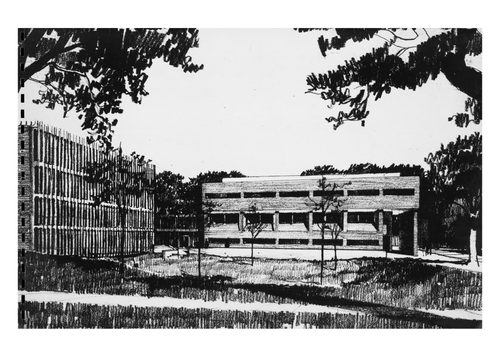The Carleton instrument shop got its start in 1948 when Russ Ferlen was hired as a “Machinist Technician” for Physics and Astronomy. Specifically, he was brought on board to do “the machinist’s work which Professor Fath has in mind.” He was initially hired on a six month appointment, which was then extended indefinitely the following year, upon everybody’s extreme satisfaction with the work Ferlen was doing.
The shop began in Laird Hall of Science, Room 1. Little is known about how this first shop was set up, but we still have three Atlas machines from model year 1947: a lathe, a horizontal milling machine, and a shaper. One could speculate that Ferlen’s first task as the Machinist Technician was to acquire the tools to do his job and these three modest machines may have been the heart of that effort.
Physics and Biology moved from Laird to the new Olin Hall in the summer of 1961, and Russ Ferlen’s operation moved too. Russ’s title also changed at that time; from then on he was official known as the Instrument Maker. The move to Olin included a tremendous expansion of the shop into a brand-new space on the ground floor of the new building. Ferlen oversaw the acquisition of a complete shop full of equipment. He was quite ambitious and selected some of the best equipment available. Records of these purchases have survived and most of the machines and specialty tools still in use in the shop were purchased for that shop expansion.
The next big change for the Instrument Shop came with the completion of Mudd Hall and the unexpected passing of Russ Ferlen in 1976. The new science building included a space for the instrument shop and it was again the job of the new instrument maker, now Warren Ringlien, to set up the shop. When Warren arrived he found an empty space in the basement of Mudd and he set to the task of deciding how to use the allotted space. Warren’s notes show that he gave careful consideration to how much space was needed for each machine, and how the arrangement could accommodate the likely workflow. Although the new space was adequate in size it was not spacious and Warren was heard more than once to complain about how much square footage was taken up by the walls.

Here is a rendering looking from the west toward Mudd Hall as it would have been in 1976. Olin Hall is on the left. The shop in Olin was in the lowest level, facing south. In Mudd Hall the shop is in the north east corner of the building, i.e. on the far side of the building on the left. You can no longer see this view of the buildings because Hulings hall, built in 1996, stands in the foreground.
The shop continued under Warren’s steady direction building high-quality apparatus. Warren made a few equipment additions, including a TIG welder, a cutter grinder and a second lathe for the student shop. For the most part, however, the equipment purchased in 1961 was all high-quality and was well-maintained so little replacement or addition was needed. At the time of his death in the fall of 2007, Warren had served as the Instrument Maker for 31 years.
In 2008, the position of Instrument Maker was reimagined as the Instrument Project Manager with the hiring of Mark Zach. This title change was intended to convey a wider reach and broader role of the shop. While the main focus of the Instrument Shop was still the creation and maintenance of top-quality scientific apparatus, Mark worked to expand the influence of the shop, offering seminars in computer aided design and making the facilities and services available to the entire campus. During the demolition of Mudd Hall, and the construction of Anderson Hall, Mark oversaw the temporary move of the Instrument Shop into the old Arena Theater, and helped envision what the new Instrument Shop would look like in Anderson.
After more than a decade of helping the Carleton community with their making needs, Mark moved on to pursue other opportunities in the engineering world, and Aaron Heidgerken-Greene was hired in his place. Aaron came to Carleton after a decade of building hands-on interactives for the Science Museum of Minnesota. Under his supervision, the shop moved from the old Arena Theater to it’s current location in Anderson Hall. During this time, the Shop also began to merge with new Class of 1969 Makerspace, placing a new emphasis on engaging all of the Carleton community.
Eric Hillemann contributed to this item.